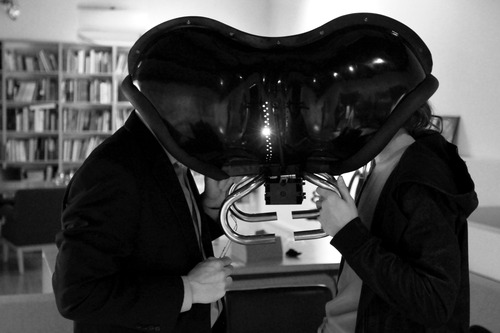
The following is an excerpt of a new Online Exclusive. Read the full piece on Believermag.com.
CAN A CARDBOARD BOX GENERATE EMPATHY BETWEEN TWO STRANGERS? CAN IT HELP THEM TO FALL IN LOVE?
DISCUSSED: Womb Twins, An Affection for Shiny Things, Shared Identities, Circus-Contortionist Grandmothers, Dutch Jungians, The Technological Scarring of the Real World, A Futuristic Darth Vader Feel, Michael Stipe
Jon and a stranger got inside the box and faced each other on either side of the two-way mirror. The box covered their heads, necks, and upper shoulders. Jon and the stranger established eye contact. During a preprogrammed four-minute sequence, LED lights inside the chambers faded in and out, blending their faces from right to left and back again on the surface of the glass. When the light on Jon’s side was brighter, he saw more of himself and less of the stranger. When his light was weaker, his face became obscured by the stranger’s face on the other side of the mirror.
Jon stayed in the box as a series of new strangers replaced one another on the other side of the mirror. Finally, Megan Daalder took a turn. Megan invented the Mirrorbox, which, before settling on a final title, she had called “the Soul Collider” and “the Empathy Accumulator.”
Jon saw his face illuminated and then gradually become Megan’s face. In the middle of the four-minute sequence, he saw the left side of his face blending with the right side of hers. The two became one person. Jon experienced the whole gamut of emotions, he claims, and then the box went black.
Jon filled out a survey afterward, which contained questions about how much he identified with animals, whether he gets called “sensitive,” and if he experienced any aftereffects from the box. He does identify with animals, he does get called sensitive, and when he left the box, he was in love—whether with the box or with Megan, he wasn’t sure.
Jon wondered how real his feelings were. He had felt so connected, so loved, but would those feelings continue to exist outside the box? Was it real love or just a substitute manufactured by the machine? Could art create the real thing?
Soon thereafter, Jon invited John Houx—a fair-skinned folk singer with full lips and a powerful voice—to Megan’s house to experience the Mirrorbox with her. Houx says meeting Megan was like meeting Doc Brown from Back to the Future. She looked like a wacky scientist, albeit one wearing a blue and white dress. Megan’s physical appearance is striking: she is especially tall; her shoulders are broad and angular; her arms are sinewy and muscular; her eyes are piercing and multicolored (mostly...
You have reached your article limit
Sign up for a digital subscription and continue reading all new issues, plus our entire archives, for just $1.50/month.
Already a subscriber? Sign in




